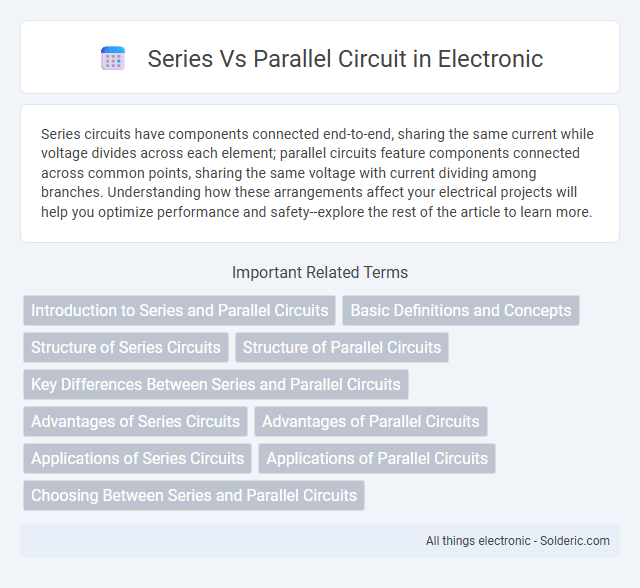Series circuits have components connected end-to-end, sharing the same current while voltage divides across each element; parallel circuits feature components connected across common points, sharing the same voltage with current dividing among branches. Understanding how these arrangements affect your electrical projects will help you optimize performance and safety--explore the rest of the article to learn more.
Comparison Table
| Feature | Series Circuit | Parallel Circuit |
|---|---|---|
| Current | Same through all components | Divides among branches |
| Voltage | Divides across components | Same across all branches |
| Total Resistance | Sum of all resistances (R_total = R1 + R2 + ...) | Inverse sum of reciprocals (1/R_total = 1/R1 + 1/R2 + ...) |
| Effect of Component Failure | Entire circuit stops | Other branches continue to operate |
| Usage | Simple devices, like Christmas lights | Household wiring, complex circuits |
Introduction to Series and Parallel Circuits
Series circuits connect components end-to-end, allowing current to flow through a single path, which means the voltage divides among the components while the current remains constant. Parallel circuits provide multiple paths for current by connecting components across common points, ensuring the voltage across each component remains the same, but the total current splits based on resistance. Understanding the differences in current flow and voltage distribution in series and parallel circuits helps you design efficient electrical systems tailored to specific needs.
Basic Definitions and Concepts
Series circuits have components connected end-to-end, allowing a single path for electric current flow, causing the same current to pass through all components with voltage dividing among them. Parallel circuits consist of components connected across common points or junctions, providing multiple paths for current, resulting in voltage remaining constant across each parallel branch while the total current splits. Understanding these fundamental differences aids in analyzing circuit behavior for applications like voltage distribution and current control.
Structure of Series Circuits
In a series circuit, all components are connected end-to-end forming a single path for current flow, with each device linked sequentially. The same current passes through each component, making the total resistance the sum of individual resistances, which impacts voltage distribution. This structure results in voltage drops across components proportional to their resistance, affecting the overall circuit behavior.
Structure of Parallel Circuits
Parallel circuits consist of multiple electrical components connected across the same voltage source, creating multiple branches with independent pathways for current flow. Each component in a parallel circuit experiences the same voltage, while the total current is the sum of the currents through each branch. This structure allows for consistent voltage across devices and enables individual components to operate independently without affecting the entire circuit.
Key Differences Between Series and Parallel Circuits
Series circuits feature components connected end-to-end, allowing current to flow through each component sequentially, resulting in the same current across all elements but a divided voltage. Parallel circuits have components connected across common points, providing multiple paths for current, which ensures the voltage across each component is equal while current varies. Understanding these key differences helps you design electrical systems optimized for specific functions and reliability.
Advantages of Series Circuits
Series circuits offer the advantage of simple design and easy implementation, making troubleshooting straightforward since current flows through each component sequentially. Your devices in a series circuit share the same current, which ensures consistent operation and prevents overpowering individual components. This arrangement also requires fewer wires and connections, reducing material costs and potential points of failure.
Advantages of Parallel Circuits
Parallel circuits provide consistent voltage across all components, ensuring your devices operate at their optimal performance. They allow independent control and operation of each electrical path, so one device can fail without disrupting the entire system. This design enhances reliability and makes troubleshooting easier in complex electrical networks.
Applications of Series Circuits
Series circuits are commonly used in applications where the same current must flow through all components, such as in Christmas lights or old-style holiday string lights. They are ideal for devices like voltage dividers and battery management systems, where controlling voltage distribution is essential. Your understanding of these circuits can enhance troubleshooting in systems where uniform current flow is crucial.
Applications of Parallel Circuits
Parallel circuits are widely used in household electrical wiring to ensure that each appliance receives the full voltage independently, allowing devices to operate simultaneously without affecting each other. In automotive electrical systems, parallel configurations provide reliable operation of lights and accessories by maintaining consistent voltage across components. Parallel circuits are also critical in electronic devices like smartphones and computers, where multiple components must function concurrently and maintain steady performance.
Choosing Between Series and Parallel Circuits
Choosing between series and parallel circuits depends on your specific electrical needs and safety requirements. Series circuits provide a single path for current, causing all components to share the same current but making the circuit susceptible to a total shutdown if one component fails. Parallel circuits allow multiple current paths, ensuring devices operate independently and maintain consistent voltage, which is ideal for household wiring and complex electronic systems.
series vs parallel circuit Infographic

 solderic.com
solderic.com